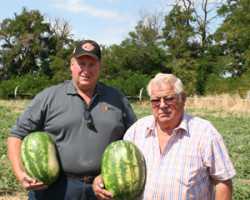How Third Party Certification Helped Grower Market Melons

Each summer about mid-July, the pilgrimage to north-central Oregon begins. It’s not a religious experience — though some watermelon lovers might argue — but for a taste of the vaunted Hermiston watermelon.
“We get a lot of people from Portland, Seattle, and Utah. People come from miles around to get our melons,” says Bob Walchli, the owner of Hermiston Melon Co. “Even if they grow melons right in their backyards, they still come for Hermiston melons. That’s a pretty neat feeling.”
Walchli says he and the other growers in the area owe their success to the previous generation, who built the reputation. “They’d take an old pickup, fill it up with melons, and head to Portland and Seattle, even if there were no paved roads,” he says. “They’re the ones that built the name ‘Hermiston melons.’ It’s up to us to keep up that tradition of Hermiston quality.”
The Walchli family’s own tradition in the area began with Bob’s grandfather Ernest, who came to Hermiston from Switzerland in 1923. Bob’s dad Skip built up Walchli Farms, and today farms a total of 2,300 acres, 300 acres of melons. Bob’s own company, Hermiston Melon Co., grows 100 acres of melons, as well as such vegetables as peppers, tomatoes, onions, and squash.
Trick’s In The Brix
Growers like Skip Walchli couldn’t have built such a great reputation without a great product. So what makes Hermiston melons so special? The key is that they are harvested at 11.5 to 12.5 Brix, says Bob Walchli. If they let them get any higher, they’d start getting over-ripe, above 13 Brix.
They are able to achieve such a high Brix because the region has tremendous fluctuations in temperature that helps bring up the sugar. An average summer day will top out at about 100°F, but the mercury will plunge into the 60s at night. “That’s what brings the sugar up in watermelons,” says Walchli.
Another key is nutrition. They sample the soil extensively, constantly checking to make sure the levels of both major and minor nutrients are just right. According to Walchi, they utilize black plastic mulch and a drip system with which they spoon-feed the plants with nutrients throughout the growing season. They also check water levels frequently with neutron probes, as Walchli says over-watering is probably the most frequent mistake he sees.
“Melon is a desert plant,” he says. “It doesn’t use as much water as you think, even though it is a watermelon.”
He’s now growing about 10% yellow flesh (Yellow Honey Heart) and 5% orange flesh (Orange Sunshine) watermelons, and those percentages keep going up because people think they’re sweeter. That’s not true, says Walchli, as in blind taste tests people can’t tell the various colors apart. And while
in other parts of the country seeded melons are something of an endangered species, Walchli still grows about 25% seeded melons as they’re still popular
in the Pacific Northwest and in Canada, a sentiment he heartily endorses.
“They’re a better buy and I like the flavor of a seeded melon,” he says. “Seriously, in summertime, a picnic’s not a picnic if you don’t spit a seed.”
‘HealthyClean’
Walchli has seen the handwriting on the wall. Consumers are paying more attention to the foods they eat, and they want “clean” food. It can be seen in the growth of organic vegetables. But it goes beyond organic. It’s tied in with the idea of food safety, but it goes beyond that too. It’s a desire, for lack of a better word, for purity.
“People are becoming more and more health-conscious,” says the Hermiston, OR, vegetable grower. “It’s something that seems to be in the backs of everyone’s minds.”
So he won’t get left behind, Walchli is trying to get away from using so many chemicals. He can’t grow watermelons, his signature product, organically, at least not yet. “We still have to fumigate for nematodes and diseases like verticillum wilt and fusarium,” he says. “We haven’t figured out a way to get away from it.”
So while he will continue to shank in metam sodium prior to planting, he’s farming some of his melons without any crop protectants once the plants are in the ground. “We think we can take care of any problems with acid-based fertilizers,” he says.
The problem is that there’s currently no real incentive for him to do it, because with increased scouting and other associated costs it’s a more expensive way to farm. Unlike producing organic melons, he doesn’t get paid more. But he thinks he might be able to get a premium in the future. One way might be to work out a special deal with one chain store. He’s also participating in a certification program called HealthyClean, which would allow him to stamp his melons as having been farmed with no above-ground pesticides.
HealthyClean is one of the many third-party certification programs popping up around the country to fill the void between conventionally and organically grown produce. As Walchli notes, the movement seems to be growing because of consumers’ desire for purity, and it’s aided by the burgeoning sustainability phenomenon. If it works out, Walchli said he might consider growing organically in the future.
“With the labor costs, I’m not sure we could do it,” he says. “But if the market gets bigger and demanded it, sure.”









